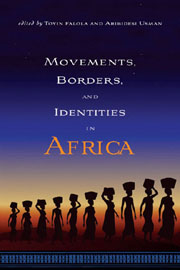Book contents
- Frontmatter
- contents
- Preface
- Introduction: Migrations in African History: An Introduction
- PART A State Formation and Migration Crossroads
- PART B Movements and Identities
- 6 Squatting and Settlement Making in Mamelodi, South Africa
- 7 “Scattering Time”: Anticolonial Resistance and Migration among the Jo-Ugenya of Kenya toward the End of the Nineteenth Century
- 8 Traders, Slaves, and Soldiers: The Hausa Diaspora in Ghana (Gold Coast and Asante) in the Nineteenth and Early Twentieth Centuries
- 9 Ethnic Identities and the Culture of Modernity in a Frontier Region: The Gokwe District of Northwestern Zimbabwe, 1963–79
- 10 Displacement, Migration, and the Curse of Borders in Francophone West Africa
- 11 Shifting Identities among Nigerian Yoruba in Dahomey and the Republic of Benin (1940s–2004)
- 12 Identity, “Foreign-ness,” and the Dilemma of Immigrants at the Coast of Kenya: Interrogating the Myth of “Black Arabs” among Kenyan Africans
- 13 Labor Market Constraints and Competition in Colonial Africa: Migrant Workers, Population, and Agricultural Production in Upper Volta, 1920–32
- List of Contributors
- Index
12 - Identity, “Foreign-ness,” and the Dilemma of Immigrants at the Coast of Kenya: Interrogating the Myth of “Black Arabs” among Kenyan Africans
from PART B - Movements and Identities
Published online by Cambridge University Press: 12 September 2012
- Frontmatter
- contents
- Preface
- Introduction: Migrations in African History: An Introduction
- PART A State Formation and Migration Crossroads
- PART B Movements and Identities
- 6 Squatting and Settlement Making in Mamelodi, South Africa
- 7 “Scattering Time”: Anticolonial Resistance and Migration among the Jo-Ugenya of Kenya toward the End of the Nineteenth Century
- 8 Traders, Slaves, and Soldiers: The Hausa Diaspora in Ghana (Gold Coast and Asante) in the Nineteenth and Early Twentieth Centuries
- 9 Ethnic Identities and the Culture of Modernity in a Frontier Region: The Gokwe District of Northwestern Zimbabwe, 1963–79
- 10 Displacement, Migration, and the Curse of Borders in Francophone West Africa
- 11 Shifting Identities among Nigerian Yoruba in Dahomey and the Republic of Benin (1940s–2004)
- 12 Identity, “Foreign-ness,” and the Dilemma of Immigrants at the Coast of Kenya: Interrogating the Myth of “Black Arabs” among Kenyan Africans
- 13 Labor Market Constraints and Competition in Colonial Africa: Migrant Workers, Population, and Agricultural Production in Upper Volta, 1920–32
- List of Contributors
- Index
Summary
Introduction
The aim of this study is threefold. First, it is a reevaluation of ethnicity and identity at the coast of Kenya, focusing on the false identity of “Black Arabs” that has been invented among the Swahili people of the coast of Kenya. The study reveals that while there is a copious collection of cultural and social histories with strong indications of ethnic tensions in Kenya, the coast of Kenya has often been seen as homogenous and cohesive. Studies have privileged the records of descendants of Arabs and Muslim archival and written sources, while ignoring the everyday experiences of descendants of Africans and their role in defining their identity and historical processes. My contention is that the ordinary voices of African folk have not found their way into historical studies at the coast of Kenya.
Second, through a discussion of the way people define themselves, the study seeks to throw light on how identity has increasingly become fluid and flexible, creating new multicultural and hybrid threads that are highly visible in the urban areas at the coast of Kenya. I believe that addressing these critical issues of cultural identity is pivotal at a time when we can see deepening patterns of cultural balkanization and all kinds of violence—a product of the uncertainty precipitated by the proliferation of difference as a consequence of globalization. The objective is to affirm that contrary to previous studies, which have embellished, valorized, and sanitized the dominant Swahili coastal culture as fixed, static, and unchanging, there has been a great deal of hybridity and multiculturalism that has been added to the Swahili culture through the diffusion of mainly African ideas and that has not been interrogated.
- Type
- Chapter
- Information
- Movements, Borders, and Identities in Africa , pp. 261 - 284Publisher: Boydell & BrewerPrint publication year: 2009

